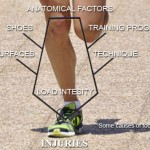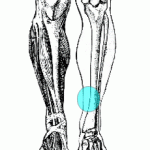Reduce Injury. It should be each runner’s common goal to reduce the risk of injury, one of the solutions is to minimise impact.
Injuries are the pits. The physical part is bad enough, but mentally they can be even worse. Half of your brain rationally advises caution while the other half screams, “Get out the door!”
 To control injuries, whilst you are in heavy training for a race like the Old Mutual Two Oceans Marathon, it’s not enough to just rest; you need to understand their root causes. Preventing injuries is about increasing the ability of your tissues to tolerate a force repeatedly, or decreasing the cumulative shock those tissues must withstand. I believe that most overuse syndromes will respond to rest, training modification and a change in the running surface or shoe. Rest is self-explanatory. Let’s look at how to prevent injuries by adjusting your running surface and terrain, shoes and mileage.
To control injuries, whilst you are in heavy training for a race like the Old Mutual Two Oceans Marathon, it’s not enough to just rest; you need to understand their root causes. Preventing injuries is about increasing the ability of your tissues to tolerate a force repeatedly, or decreasing the cumulative shock those tissues must withstand. I believe that most overuse syndromes will respond to rest, training modification and a change in the running surface or shoe. Rest is self-explanatory. Let’s look at how to prevent injuries by adjusting your running surface and terrain, shoes and mileage.
Our bodies didn’t evolve to withstand hundreds of kilometres of pounding on the hard, uniform surfaces of pavements and roads. Although these may be the most convenient surfaces available, you’re inviting shin splints, stress fractures and other injuries by training on them exclusively. A better strategy is to switch to softer surfaces such as dirt, grass or gravel as much as possible. If you are a Capetonian runs through Cecilia plantation to the “Nek” or Jack’s track in Newlands forest provide for a friendlier surface as well as a more variable ride, which reduces the repetitiveness of the load.
The cushioning materials in all running shoes break down substantially after 800 kilometres, often less. Keep careful track of the number of kilometres you’ve logged in your shoes and replace them as needed. The impact forces of running shift slightly from one pair of shoes to another. Try rotating shoes on different days to make the shock that your feet, legs and back receive, become somewhat less repetitive. In addition, research has shown that it takes time for shoes’ resiliency to completely return after running- which means that if you train twice a day, rotating shoes may be more beneficial for injury prevention.
Predictors of future running injury
Weekly mileage is one of the strongest predictors of future running injury. For most, the best way to stay in awesome shape without frequent breakdown, is to cross-train or replace some running kilometres with forms of aerobic training. Cross-training options are cycling, swimming and the option that I like the best, running in a pool with a flotation vest. This is the closest substitute to running and is used by many athletes to maintain fitness whilst recovering from injury.
By combining these strategies, you can maximise your chances of staying injury free in your build up to major races. If you still feel an injury coming on, take a day or two off to allow muscles and connective tissue to recover and resiliency to improve. You may then avoid several weeks off with a more serious injury.
Article by Dave Spence – Resident coach Cape Town
View the articles under the Injury and Treatment section:
- To reduce injury risk, you need to minimise impact
- Injury Treatment Approaches
- Leg & Foot Cramps
- Water Running
- The Gift of an Injury
- Injury prevention tips
- The best predictors of injury
- The Comeback from Injury
View: Injury guide – Sites of the Most Common Running Injuries























